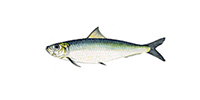Thank you for visiting the Seafood Selector. EDF is planning a new approach to providing information to consumers about good seafood choices. Please come back soon for updates.
Sardines

Sardine
Recommended servings per month
| Contaminant | Men | Women | Kids 6-12 | Kids 0-5 | |
|---|---|---|---|---|---|
| Japanese sardinellas | Mercury | 4+ | 4+ | 4+ | 4+ |
| Orangespot sardines | Mercury | 4+ | 4+ | 4+ | 4+ |
| Pacific sardines (U.S. & Canada) | Mercury | 4+ | 4+ | 4+ | 4+ |
| Spanish sardines | Mercury | 4+ | 4+ | 4+ | 4+ |
| European pilchard sardine (imported) | Unknown |
Eco details:
Sardines reach sexual maturity quickly and spawn several times a year. Since they quickly replenish their numbers, they are very resilient to fishing pressure. Most populations appear to be healthy.




